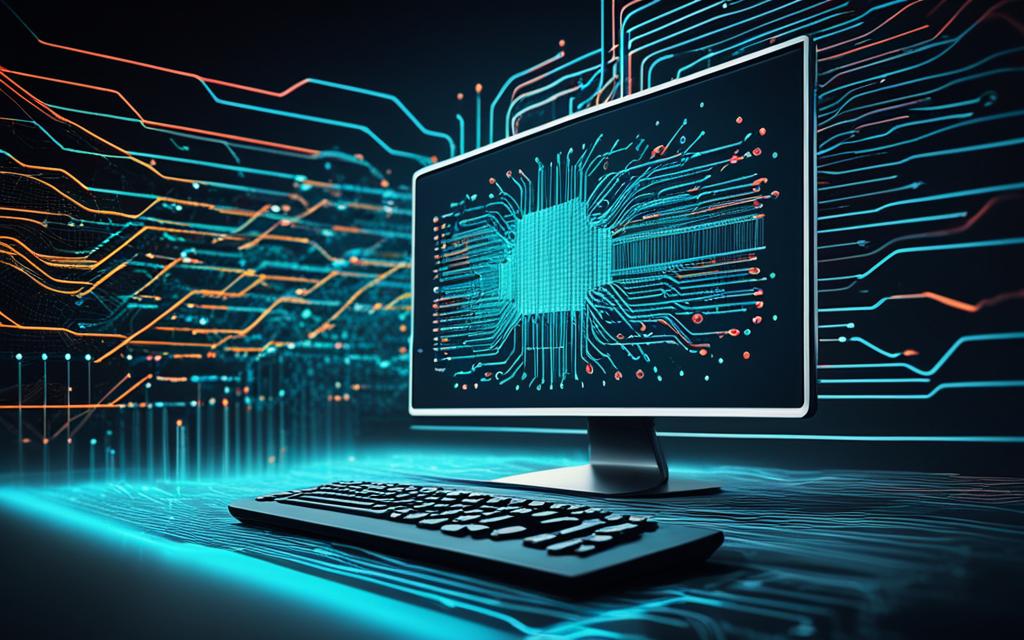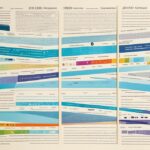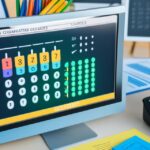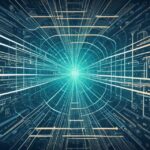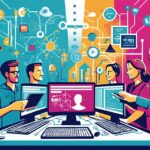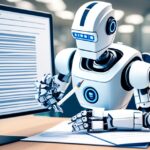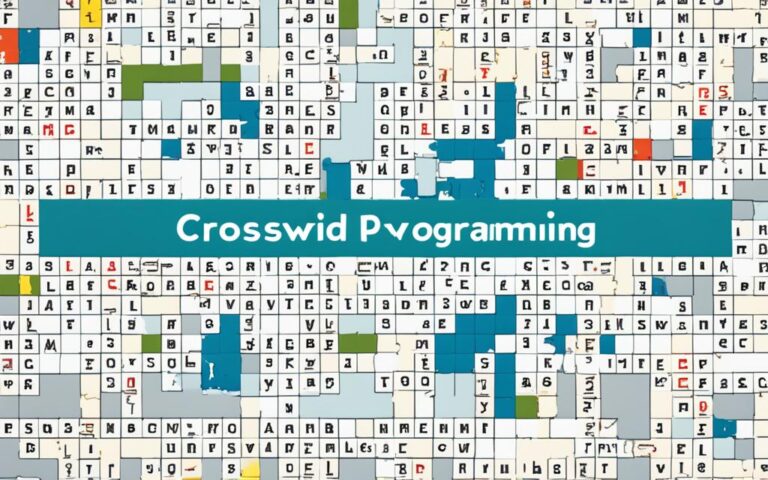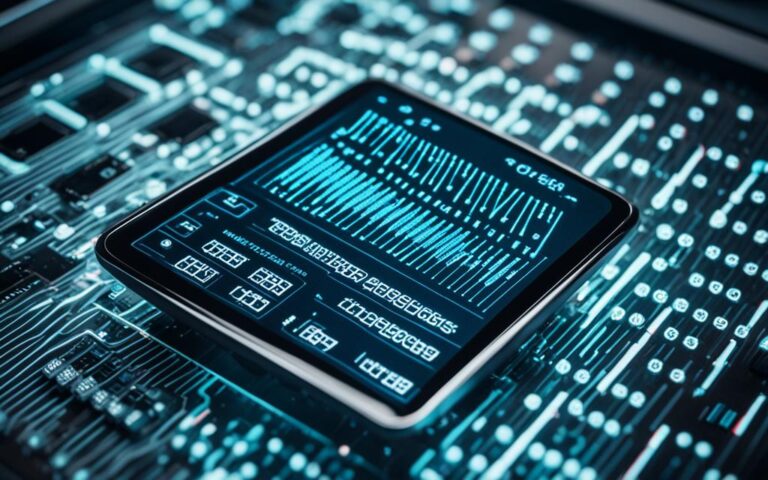The New York Times has recently explored computer programming’s history and impact. This article will highlight the main points and offer insights into coding.
Computer programming started in the 1950s1. Back then, only a few Americans knew about computers and coding. The first digital computers were built in universities and government labs1. By 1965, even top schools like Stanford didn’t have a computer science department1.
The IBM 704, a key computer, had a small memory for code1. Programmers wrote code on paper and then put it on punch cards to use in the computer1.
Today, computer programming is more popular than ever. The New York Times started publishing puzzles in 2012, helping to grow interest2. For 17 years, puzzles have kept enthusiasts busy, using tools like CrossFire and Crossword Compiler2.
Key Takeaways:
- The history of computer programming dates back to the 1950s when it was a relatively unknown field1.
- The New York Times has played a significant role in popularizing crossword-style puzzles2.
- Early programming involved manual coding and the use of punch cards1.
- Computer programming has evolved immensely since its early days1.
- The interest in crossword-style grids and puzzle construction has grown over the past 17 years2.
The Joys of Computer Programming
Looking back, my early days with computer programming were filled with excitement and wonder. It was the 1980s, and the Sinclair ZX Spectrum had just arrived. This opened up a new world for aspiring programmers like me.
Programming lets us make machines do things with code. It’s like creating something from nothing. It blends creativity with logic, making our ideas real.
Writing programs on my ZX Spectrum made me feel proud. Solving problems was both hard and rewarding. It taught me to keep going, even when things got tough.
Programming is like an art, where every code line is important. Paying attention to details is key, as small mistakes can mess up the whole program. Finding and fixing these errors can take a lot of time. But when it works, the joy is unbeatable.
Many people don’t realize how complex programming is. It needs patience, precision, and analytical thinking. It’s like building a car from scratch or making your own maps for a trip. You have to think of everything and plan for every possibility.
| Statistical Data | |
|---|---|
| Year | Percentage Growth |
| 2005-2015 | 177% |
| 2005-2015 | 251% |
| 2005-2015 | 143% |
Computer programming has grown a lot over the years. The Computing Research Association says computer science majors have doubled since 20113.
It’s not just computer science majors who are getting into programming. Courses for nonmajors have seen big increases too, from 2005 to 2015. These numbers show the growing interest in programming3.
This rise in interest shows how valuable programming is today. It opens up new career paths and lets people shape the digital future.
Thinking back to my ZX Spectrum days, I see programming as more than a skill. It’s a source of joy and inspiration. It lets us bring our dreams to life and explore technology’s endless possibilities. So, if you haven’t tried programming yet, I suggest you do. You might find a new world of creativity and happiness.
The Evolution of Programming
In my high school and college days, I was drawn to computer programming. Yet, I chose writing as my career path. This choice was influenced by the need to learn specific programming languages to communicate with computers. It seemed odd, given the rapid tech advancements, that we had to learn such precise languages.
The history of programming shows us why these languages were needed. The first high-level language, Plankalkül, was created by Konrad Zuse from 1942 to 19454. This was a key moment in programming history.
Then, in 1956, FORTRAN was developed by John Backus at IBM4. It was the first commercial programming language. FORTRAN made programming easier by using a language closer to human language. This change was a big step forward.
Later, LISP was invented in 1958 by John McCarthy, and COBOL was created in 19594. These languages brought new ideas and ways of programming.
By the late 1960s and mid-1970s, languages like Simula and Smalltalk introduced object-oriented programming4. This approach changed how we organize code and data.
In 1969, FORTH was created by Charles Moore, offering a simple yet flexible way to write code4. This language showed a new path in programming.
The development of C by Dennis Ritchie and Ken Thompson in the early 1970s was a major breakthrough4. C became a key language, known for its efficiency and versatility.
Ada Lovelace, in the mid-1800s, was a pioneer in computer programming5. Her work included ideas on how codes could interact with machines and loop processes still used today5.
| Year | Event |
|---|---|
| 1956 | Fortran, the first modern computer language, was shared with the coding community6. |
| April 1957 | Customer code for Fortran was shipped6. |
| 1957 | Programs that previously took weeks to write now only took hours with Fortran6. |
| 1957 | Fortran made programs portable, overcoming the limitations of running only on specific computer architectures6. |
| 1957 | Fortran won the battle against assembly language and was extensively adopted by the scientific and military communities, including in space and military projects6. |
| 1957 | Fortran was described as one of the first high-level languages to simplify programming and increase efficiency6. |
| Present | Dozens of high-level languages exist today, with ongoing use and development of Fortran within specialized communities6. |
Programming languages have evolved to make things more efficient and easier to understand. Today, we have many languages, each with its own strengths. As technology keeps advancing, we’ll see more changes in programming.
AI and Programming
Artificial Intelligence (AI) has changed many fields, including computer programming. With new AI like Codex, programming has grown a lot.
Codex, made by OpenAI, uses machine learning and natural language processing. It’s a game-changer for both professional coders and new programmers. It can make computer programs quickly and accurately.
Studies show7 that OpenAI started sharing GPT-3 in summer 2020. At first, only a few developers could use it. But soon, GPT-3’s language skills were all over the internet and social media, making people think of sci-fi like HAL 9000.
GPT-3 approaches a fluency that resembles creations from science fiction like HAL 9000 from “2001”7.
GPT-3 learned by reading thousands of digital books and the internet. This made Codex great at making new language and code. It’s a big help for experts and beginners alike.
One test with Codex showed how well it could understand complex topics. It talked about creativity with Scott Barry Kaufman, a pop psychologist. Kaufman said it was “Crazy accurate A.I.”
GPT-3 can do more than just code. It can tweet, write poetry, summarize emails, answer questions, translate languages, and even make computer programs. This shows how it can change AI and programming.
GPT-3 and Codex are big steps towards making machines understand human language and skills. They don’t replace human coders but help them work better and be more creative.
Coding as a Valuable Skill
In today’s world, coding is a key skill that opens doors for the future. It’s no longer just for tech experts but a must-have for many jobs. Knowing how to code is vital in many areas, making it a sought-after skill.
Estonia is leading the way in tech education by offering scholarships for tech subjects8. This shows how coding is becoming essential in the job market. More people need to know programming languages.
Now, every child in England starts learning computer programming at age five8. This makes coding as important as reading and writing. It prepares them for tech jobs later on.
28 million people tried programming thanks to the “Hour of Code” initiative8. This shows how coding is gaining popularity as a valuable skill. It’s seen as crucial for both career and personal growth.
Coding education is growing worldwide, from primary school to Ph.D. levels8. This shows how coding is becoming a basic skill needed for the future. It’s important for careers, economic growth, and the tech industry.
Teaching coding early helps break down stereotypes about computer science8. It shows the creative side of programming and helps solve problems. This makes more people interested in tech.
Clive Beale says knowing how technology works is vital8. Coding gives people the skills to shape the future. It makes them creators, not just users, of technology.
Coding is fun and rewarding for kids. They get to make their ideas come to life. This makes them feel proud and excited about coding.
Roxanne Emadi points out that kids use technology a lot but don’t know how to make it8. Coding education is key to giving them the skills for the digital world.
Learning to code prepares people for future jobs and helps grow technology. It’s not just about getting a job. It’s about making a difference and driving innovation in many fields.
Coding Enrollment Trends
| Course Level | Percentage Increase from 2005 to 2015 |
|---|---|
| Introductory Computer Science | 177% |
| Mid-level Computer Science | 251% |
| Upper-level Computer Science | 143% |
Computer science courses saw a huge increase in nonmajors from 2005 to 20153. This shows how coding is becoming more popular and important. It’s not just for computer science majors anymore.
At the University of California, Berkeley, 500 students take “The Beauty and Joy of Computing” every year3. This shows how much people want to learn coding. Since 2011, computer science majors have grown, showing coding’s value in the job market3.
Coding is key for today’s literacy and job skills. It combines creativity, problem-solving, and tech knowledge. This makes coding a great way to succeed and help society and innovation grow.
The Role of AI in Programming Education
AI has changed many fields, including programming education. Tools like GPT-4 are making learning easier and coding simpler9.
AI helps students by offering personalized help, real-time feedback, and solutions. This makes learning more interactive and suited to each student’s needs9.
Khan Academy is a great example of AI in education. It has over 150 million users worldwide, making education more accessible9. The platform is available in many languages, showing its global impact9.
Salman Khan, the founder, focuses on creating quality content. AI helps make learning better by providing structured lessons9.
GPT-4 is a big step forward in AI technology. It impressed Salman Khan in July, showing great potential for programming education9. GPT-4 could change how students learn to code9.
https://www.youtube.com/watch?v=dxdtZrTCMao
AI tools like GPT-4 make coding easier and faster. Students can write code better, debug, and learn new things with AI’s help9. This helps students understand programming better and be more creative9.
AI also helps with more than just coding skills. A LinkedIn study found over 500 skills will be affected by AI technologies10. As AI grows, learning about AI is key for students to succeed in the future10.
AI in programming education is set to grow. It makes learning better and prepares students for the tech world10. With tools like GPT-4, programming education is becoming more accessible and effective910.
The Decline of Coding as a Skill
Technology is moving fast, making us wonder if coding is still a key skill. AI and automation could change many industries, including programming. Could coding, once seen as vital, be losing its importance?
A New York Times article says coding went from being a niche interest to a big deal, even challenging Microsoft Windows with Linux (The Rebel Code)11. Linux, made by Linus Torvalds at 21, is known for running long without crashing11. But, technology keeps changing.
Now, we’re seeing a big AI change, with big wins like better Google Translate. A study by Hiroshi Ishii and others got over a hundred thousand Twitter followers12. This shows AI’s power in changing language translation and how we interact with computers (The Great AI Awakening). AI is making coding change, with tools like GPT-4 and ChatGPT Plus13.
“Artificial intelligence is getting better at writing code, even complex code, with less human help,”
This change might mean fewer people need to know a lot about coding. AI tools can do coding tasks fast and well13. This could mean less need for traditional coding skills13. It might change what we teach in coding classes and what skills future programmers need.
Ben made an iPhone app quickly with AI help, showing how AI is changing app development13. Making software is getting easier, tasks once for experts only are now simpler. AI tools can write code fast for specific tasks, making things faster and more efficient13. This could mean less need for manual coding for apps13.
Even with these changes, coding is still important. Understanding and changing code is key for some jobs and areas. Coding is crucial for making new technologies and driving innovation. So, experts with deep coding knowledge will always be needed.
As tech changes, programmers and professionals must adapt and learn about AI’s impact on coding. The role of coding might change, but learning new tech is key to success in this field.
The Future Landscape of Coding
The future of coding is uncertain with AI and automation on the rise. AI’s progress might reduce the need for traditional coding skills. But, this doesn’t mean coding isn’t important anymore. It’s about rethinking what skills future programmers need. Learning to adapt, understand new tech, and grasp AI’s role in coding will be vital for success.
The Endless Depth of Coding
Coding is a vast and intricate domain that never ceases to amaze. The sheer endless depth of possibilities and knowledge it encompasses is both exhilarating and humbling. Each line of code has the potential to solve complex problems, create innovative solutions, and shape the future of technology.
Reflecting on my own journey in programming, I am reminded of the endless depth that coding offers. From learning basic programming concepts to tackling complex algorithms, every step has been a revelation. It shows the limitless possibilities within the world of coding.
Advancements in artificial intelligence have inspired me. AI-powered coding assistants like GPT-4, introduced by Ben, have pushed coding boundaries13. Seeing AI generate code efficiently and quickly, as Ben did with an iPhone app in hours13, is awe-inspiring.
AI has changed how we view coding skills. Technologies like ChatGPT can write code, redefining the human role in coding13. AI’s rapid progress suggests a future where humans and AI collaborate, opening new possibilities and pushing limits13.
AI’s impact goes beyond tech. Stories like Lee Sedol’s Go match against AlphaGo make us think about coding’s future and our relationship with technology13.
My coding journey shows the endless depth of coding. From basic programs to complex projects like scraping the Masters Tournament leaderboard, each project has expanded my knowledge and showcased coding’s potential13.
| Glimpses of the Endless Depth of Coding | Year |
|---|---|
| The first volume of “The Art of Computer Programming” was published. | 1968 |
| The collected volumes of “The Art of Computer Programming” were included in a list of books that shaped the last century of science. | 2013 |
| Over one million copies of “The Art of Computer Programming” are in print. | – |
| The boxed set of volumes of “The Art of Computer Programming” is sold for about $250. | – |
| The Knuth-Morris-Pratt string-searching algorithm was devised. | 1970 |
The endless depth of coding is vast, not just in individual achievements. OpenAI’s GPT-3 has amazed the world with its language skills, making it seem like science fiction7. GPT-3’s supercomputer is incredible, with 285,000 CPU cores, solar power, and industrial fans for cooling7. GPT-3 shows AI’s huge potential in changing industries, including coding and education7.
In conclusion, coding’s endless depth is a constant source of inspiration and discovery. As we explore this ever-changing field, we see our limits expanding. The blend of human creativity and AI’s power deepens our coding understanding, opens new areas, and sparks innovation.
The Changing Perception of Hackers
Over the years, the way we see hackers has changed a lot. They used to be seen as cyber villains. Now, they are viewed as highly skilled experts in programming and AI. Many hackers learn on their own, driven by curiosity and a love for knowledge.
Starting as a hacker often comes from a deep interest in programming. They have a natural curiosity and think differently. While formal education helps, many learn by doing and never giving up.
“To be a hacker, you have to be persistent. It’s about never giving up, even when faced with seemingly insurmountable challenges. It’s about embracing failure as an opportunity to learn and grow.”
Now, hackers are seen as key players in cybersecurity. There are over 209,000 cybersecurity jobs waiting to be filled in the US14. Many experts leave government jobs for better pay in the private sector14.
Private jobs offer more money and exciting projects, drawing top talent away from government14. But, this move could leave government systems vulnerable14.
An exemption lets hackers test voting machines at Def Con, showing their value in security14. This highlights their skills and their role in protecting our systems.
Wireless networks have made hackers’ job easier. Gary Morse found many networks in Midtown Manhattan quickly15. Tools like Kismet help find these networks quietly15. A wireless card costs about $40, making hacking more accessible15.
Wireless tech is everywhere, making us more vulnerable15. Home networks are common, making cybersecurity crucial15.
Not all hackers are bad. The nature of hacking has changed, moving from curiosity to cybercrime16. Big companies focus on making money, leaving security holes for hackers16. These experts found big security issues in Microsoft products16.
The Changing Perception of Hackers – Key Takeaways
- Perception of hackers has evolved from criminal activity to skilled professionals playing a crucial role in programming and AI
- Hackers often acquire skills through self-learning, hands-on experience, and continuous learning
- There is a demand for skilled hackers in the cybersecurity field, with many leaving government positions for higher-paying private sector jobs
- Exemptions to certain acts and recognition of hackers’ contributions highlight their expertise in enhancing security
- Prevalence of wireless networks increases the potential vulnerabilities that hackers can exploit
- Hacking has shifted from curiosity-driven exploration to being a tool for cybercrime and nation-state attacks
- Large software companies prioritize investment over software security, leaving vulnerabilities for hackers to exploit
The changing perception of hackers reflects a growing recognition of their value in programming, AI, and cybersecurity. By embracing their skills, expertise, and dedication, the programming world can continue to evolve and innovate, with hackers serving as vital custodians of digital systems.
The Perception of Hackers – Statistics
| Statistical Data | Source |
|---|---|
| More than 209,000 cybersecurity jobs in the United States are currently unfilled | Peninsula Press |
| Former head of the National Security Agency mentions experts leaving for private sector jobs | Peninsula Press |
| Private sector jobs tend to pay more than government positions | Peninsula Press |
| Exemption to the Digital Millennium Copyright Act allows researchers to experiment on voting machines at Def Con | Peninsula Press |
| Over a dozen potentially vulnerable wireless networks in Midtown Manhattan within 30 seconds | Gary Morse |
| Kismet software allows for discreet detection of various wireless networks | Gary Morse |
| The cost of a wireless networking card is around $40 | Gary Morse |
| Hackers discovered significant security weaknesses in Microsoft products | Author’s company |
Conclusion
Computer programming is key in today’s fast-changing world. Learning both computer science and the U.S. Constitution is seen as vital for success17. Experts like David Coleman and Stefanie Sanford push for adding these subjects to tests, seeing their worth17.
AI is changing how we code, but programming still boosts problem-solving and creativity. OpenAI has transcribed over a million hours of YouTube to train its AI, marking a big step forward18. The GPT-4 model, built with this data, is now one of the top AI systems18.
Experts like Rumman Chowdhury and others highlight AI’s huge potential and its effects on society19. They talk about using AI for good, tackling biases, and making machines learn on their own. They aim to create AI that helps humanity19.
Coding is still a top skill that leads to many job options. With tech like computing and AI shaping jobs across sectors, knowing how to code is a must17. By keeping up with programming changes, people can move forward in their careers and help society grow.
FAQ
Is computer programming a valuable skill?
Yes, computer programming is a key skill in many areas. It helps solve problems and lets people be creative.
How can AI enhance programming?
AI tools like Codex and GPT-4 can help with coding. They make some tasks easier and faster. This could make coding easier for more people.
Will advancements in AI replace human programmers?
AI is getting better, but it won’t replace human programmers. Experts think it will help people work better. Human skills and creativity are still needed.
Is coding an essential skill for children?
Yes, coding is now seen as crucial, like reading and writing. It helps kids think logically and solve problems. It prepares them for the future.
What is the future relevance of coding?
There’s worry about coding’s future. AI and automation might change jobs. But coding will always be important for solving problems and being creative.
Source Links
- https://www.nytimes.com/2019/02/13/magazine/women-coding-computer-programming.html – The Secret History of Women in Coding (Published 2019)
- https://www.nytimes.com/2018/10/22/crosswords/who-made-my-puzzle.html – 60 Seconds With Sam Ezersky (Published 2018)
- https://www.nytimes.com/2017/04/04/education/edlife/teaching-students-computer-code.html – Learning to Think Like a Computer (Published 2017)
- https://en.wikipedia.org/wiki/History_of_programming_languages – History of programming languages
- https://www.captechu.edu/blog/ada-lovelace-mother-of-computer-programming – Ada Lovelace: The Mother of Computer Programming | Capitol Technology University
- https://www.linkedin.com/pulse/oct-15-1956-fortran-forever-changes-computings-fortunes-john-c-abell – Oct. 15, 1956: Fortran Forever Changes Computing’s Fortunes
- https://www.nytimes.com/2022/04/15/magazine/ai-language.html – A.I. Is Mastering Language. Should We Trust What It Says? (Published 2022)
- https://www.nytimes.com/2014/03/24/world/europe/adding-coding-to-the-curriculum.html – Adding Coding to the Curriculum (Published 2014)
- https://www.nytimes.com/2023/05/03/opinion/chatgpt-ai-khan-academy.html – Opinion | A.I. Could Actually Be a Boon to Education (Published 2023)
- https://www.nytimes.com/2024/02/14/opinion/ai-economy-jobs-colleges.html – Opinion | When Your Technical Skills Are Eclipsed, Your Humanity Will Matter More Than Ever
- https://www.nytimes.com/1999/02/21/magazine/the-rebel-code.html – The Rebel Code (Published 1999)
- https://www.nytimes.com/2016/12/14/magazine/the-great-ai-awakening.html – The Great A.I. Awakening (Published 2016)
- https://www.newyorker.com/magazine/2023/11/20/a-coder-considers-the-waning-days-of-the-craft – A Coder Considers the Waning Days of the Craft
- https://www.nytimes.com/2017/08/02/technology/a-solution-to-hackers-more-hackers.html – A Solution to Hackers? More Hackers (Published 2017)
- https://www.nytimes.com/2003/07/13/magazine/the-way-we-live-now-7-13-03-phenomenon-walk-by-hacking.html – THE WAY WE LIVE NOW: 7-13-03: PHENOMENON; Walk-By Hacking (Published 2003)
- https://www.nytimes.com/2013/04/05/opinion/closing-the-door-on-hackers.html – Opinion | Closing the Door on Hackers (Published 2013)
- https://www.nytimes.com/2019/02/12/opinion/college-board-sat-ap.html – Opinion | The Two Codes Your Kids Need to Know (Published 2019)
- https://www.nytimes.com/2024/04/06/technology/tech-giants-harvest-data-artificial-intelligence.html – How Tech Giants Cut Corners to Harvest Data for A.I.
- https://www.nytimes.com/interactive/2023/06/01/opinion/ai-technology-future.html – Opinion | We Spoke With 5 People Who Work With A.I. Here’s What Keeps Them Up at Night. (Published 2023)
